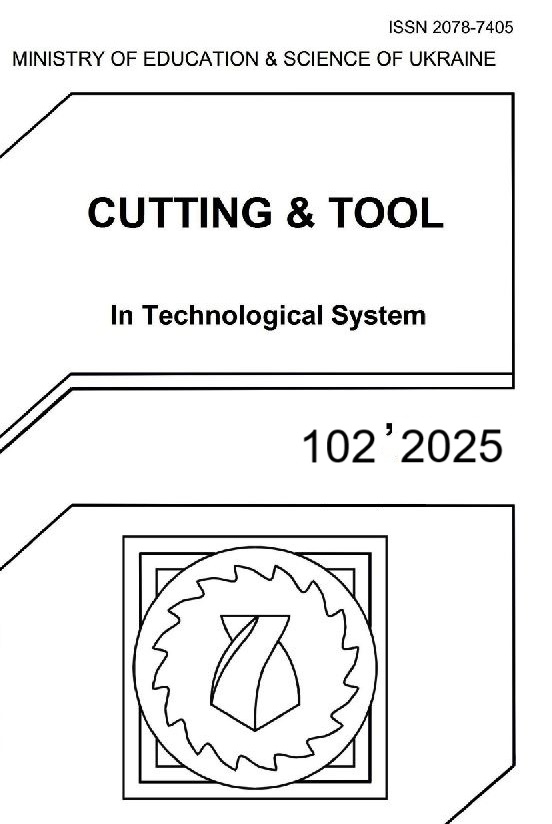COMPUTATIONAL AND ANALYTICAL MODELS OF THE MAJOR TYPES OF CUTTING TOOL FAILURE
DOI:
https://doi.org/10.20998/2078-7405.2025.102.04Keywords:
reliability, tool wear, fatigue, heavy engineering, cutting, adhesive wear, thermomechanical load, plastic deformation, cutting edgeAbstract
The paper presents analytical and numerical models for assessing the reliability of cutting tools used in the processing of critical parts for the defence and energy industries. The criteria of boundary wear on the back and front surfaces, possible fatigue failure and plastic deformation of the cutting edge are taken into account. Analytical dependencies have been constructed to calculate the number of parts that can be machined before tool failure, taking into account the physical and mechanical characteristics of the tool and processed materials, technological modes and thermal loading conditions. The results allow for the selection of tools and cutting parameters based on increased reliability and process optimisation. These mathematical dependencies make it possible to take into account the predominant type of cutting tool wear, which is especially important when working with large parts on heavy machine tools. The results of the study are of practical importance for industry, as they allow to increase the stability and productivity of technological processes.
References
A. Smith, “Tool wear mechanisms in heavy-duty machining,” Journal of Engineering Manufacture, vol. 233, no. 8, pp. 1234–1242, 2019.
I. Ivanenko, Assessment of wear resistance of cutting tools. Kyiv: Technika, 2020 (in Ukrainian).
T. Johnson et al., “Thermo-mechanical modeling of tool–workpiece interaction,” Int. J. Mach. Tools Manuf., vol. 112, pp. 1–10, 2018.
O. Kovalenko, “Tool failure mechanisms during machining of heat-resistant alloys,” Bulletin of NTUU KPI, No. 5, pp. 55–60, 2021 (in Ukrainian).
L. Chen and W. Li, “Fatigue failure prediction in cutting tools,” Wear, vol. 426–427, pp. 842–849, 2019.
M.F. Martynenko, Mechanics of metal cutting. Kyiv: Higher School, 2015 (in Ukrainian).
Dearnley, P.A., “The role of materials in the wear resistance of cutting tools,” Wear, vol. 257, no. 7–8, pp. 670–679, 2004.
Cutting theory: a textbook for students of specialty 131 – Applied mechanics / O. V. Globa, V. V. Vovk, D. A. Krasnovyd, V. I. Solodkyi; Igor Sikorsky Kyiv Polytechnic Institute. – Kyiv: Igor Sikorsky Kyiv Polytechnic Institute, 2022. – 248 p. (in Ukrainian). https://ela.kpi.ua/handle/123456789/48280
E. M. Trent and P. K. Wright, Metal Cutting, 5th ed., Elsevier, 2000.
Astakhov, V.P., Tribology of Metal Cutting, Elsevier, 2006.
Kuzmenko I.V., Thermal processes in metal cutting. Lviv: LP Publishing House, 2021 (in Ukrainian).
Jawahir, I.S., et al., "Surface integrity in material removal processes," CIRP Annals, vol. 60, no. 2, 2011, pp. 603–626.
V.Kovalov, G. Klymenko, Y. Vasylchenko, M. Shapovalov, A. Sherbakova, A. Kovalenko Methods of increasing reliability of cutting tools for heavy machine tools.Procedia Structural Integrity2024. Volume 59 https://doi.org/10.1016/j.prostr.2024.04.111
Downloads
Published
Issue
Section
License
Copyright Notice
Authors who publish with this Collection agree to the following terms:
1. Authors retain copyright and grant the Collection right of first publication with the work simultaneously licensed under a Creative Commons Attribution License that allows others to share the work with an acknowledgement of the work's authorship and initial publication in this Collection.
2. Authors are able to enter into separate, additional contractual arrangements for the non-exclusive distribution of the Collection's published version of the work (e.g., post it to an institutional repository or publish it in a book), with an acknowledgement of its initial publication in this Collection.
3. Authors are permitted and encouraged to post their work online (e.g., in institutional repositories or on their website) prior to and during the submission process, as it can lead to productive exchanges, as well as earlier and greater citation of published work.

